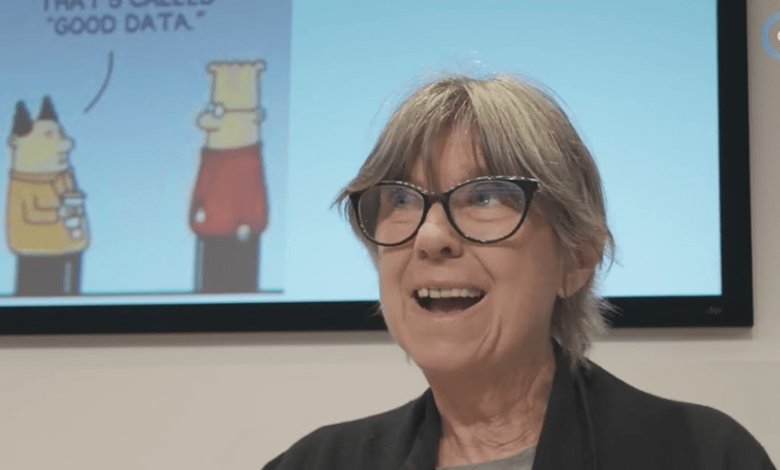2024 Annual GWPF Lecture – Judith Curry – Climate Uncertainty and Risk – Watts Up With That?


The Global Warming Policy Foundation
Dr Judith Curry gives the 2024 Annual GWPF Lecture on the subject of ‘Climate Uncertainty and Risk’.
Transcript
[Host]
Welcome, everybody, to our annual lecture. I’m extremely pleased to welcome Professor Judith Curry as our special guest, someone who may actually know something about the science. She is one of the world’s leading climate scientists, an author of over 180 scientific papers, and she’s currently president of the Climate Forecast Applications Network and hosts one of the world’s most popular climate science blogs. She’s here to talk tonight about the subjects in her new book called “Climate Uncertainty and Risk.” Thank you very much, Judith. Over to you.
[Dr. Judith Curry]
I’m delighted to be here tonight to talk with you about my favorite topic: climate uncertainty and risk. To provide some context for climate uncertainty and risk, let’s first consider the so-called climate certainties: the Earth’s climate is warming, a warming climate is dangerous, we’re causing the warming by emitting CO2 from burning fossil fuels, so we need to prevent dangerous climate change by eliminating CO2 emissions. These alleged certainties fuel apocalyptic rhetoric from UN and our national leaders. Here are some of my favorites: “The clock is ticking towards climate catastrophe.” “We are on a highway to climate hell with our foot still on the accelerator.” The UN Paris Agreement targets net zero emissions by 2050 to keep warming to within 1.5 degrees. Policymakers and others are grappling with a number of issues in addressing the Net Zero challenge. These include the technical, economic, and political feasibility, the priority of climate change relative to other problems, and unintended consequences of a rapid transition of our energy system.
Some example headlines I’ve spotted over the last two years: “Almost half of UK adults fear falling into fuel poverty before the year’s end.” “Why Dutch farmers are protesting over emissions cuts.” “Rich countries’ climate policies are colonialism in green.” African nations expect to make the case for a big rise in fossil fuel output. So how did we come to be between a rock and a hard place on the climate issue, where we are allegedly facing an existential threat, and the proposed solutions are both unpopular and infeasible? Well, in a few words, we’ve put the policy cart before the scientific horse.
In the 1980s, the UN Environmental Program was looking for a cause to push forward its agenda of eliminating fossil fuels and anti-capitalism, with the help of a small number of well-positioned activist climate scientists. A 1988 UN conference recommended that the world reduce CO2 emissions by approximately 20% by the year 2005 as an initial global goal. The implicit assumption was that the small amount of warming observed over the previous decade was caused by emissions, and that warming was dangerous. Now, 1988 was the year that the UN established the Intergovernmental Panel on Climate Change, or the IPCC. The first assessment from the IPCC in 1990 concluded that the recent warming was within the magnitude of natural variability. While that didn’t hinder the UN, they went ahead with the 1992 treaty from the UN Framework Convention on Climate Change that was signed by 196 countries to prevent dangerous anthropogenic climate change caused by emissions. The second IPCC report in 1995 found pretty much the same thing as the first one. However, in the meeting with policymakers to write the summary, there was substantial pressure for a stronger finding. They came up with the word “discernable” and then went back and changed the body of the report to be consistent. At that point, the IPCC lost any pretense of being independent or uninfluenced by politics. Apparently, “discernable” was sufficient to justify the Kyoto Protocol.
A number of leading scientists were deeply concerned. Pierre Morell, director of the World Climate Research Program, had this to say: “The consideration of climate change has now reached the level where it is a concern of professional Foreign Affairs negotiators and has therefore escaped the bounds of scientific knowledge and certainty.” William Nordhaus, Nobel laureate in economics, stated: “The strategy behind the Kyoto Protocol has no grounding in economics or environmental policy.” Mixing politics and science is inevitable on issues of high societal relevance such as climate change. However, there are some really bad ways to do this, and we’re seeing all of these with the climate change issue. Policymakers misuse science by demanding scientific arguments for desired policies, funding a narrow range of projects that support preferred policies, and using science as a vehicle to avoid Hot Potato policy issues. Scientists misuse policy-relevant science by playing power politics with their expertise, conflating expert judgment with evidence, entangling disputed facts with values, and intimidating scientists whose research interferes with their political agendas.
This Dilbert cartoon sums it up well: “What does the data tell us to do?” “How we only have bad data.” “Well, does the bad data suggest that we do what we wanted to anyway?” “Well, yes.” “That’s called good data.”
Apart from politicization, arguably the biggest issue is that we’ve oversimplified both the climate change problem and its solution. The UN has framed climate change as a tame and simple problem with an obvious solution that is demanded by the science. The precautionary principle has been invoked in the context of speaking consensus to power. However, climate change is much better characterized as a wicked problem with great complexity and uncertainty and a clash of different societal values. When viewed as a tame problem, the climate change problem is framed as being caused by excess carbon dioxide in the atmosphere, which can be solved by eliminating fossil fuel emissions. Both the problem and solution are included in a single frame, whereby the science demands this particular solution.

This framing dominates the UN negotiations on climate change. There’s another way to view the climate change problem and its solutions. The framing on the right views climate change as a complex wicked problem. This framing shows two separate frames, one associated with causes of climate change and the other associated with solutions that can help reduce vulnerability to climate change. The larger frame on the right includes natural causes for climate change, such as the sun, volcanoes, and slow circulations in the ocean. This framing is provisional, acknowledging that our understanding is incomplete, and that there may be unknown processes influencing climate change. The frame on the left is about controlling the climate, whereas the frame on the right acknowledges the futility of control. Solutions on the right focus on managing the basic human necessities of energy, water, and food. Economic development supports these necessities while reducing our vulnerability to weather and climate extremes.
My own understanding of climate change and human well-being is squarely in the framing on the right. Now, wait a minute, don’t 97% of climate scientists agree on all this? Doesn’t science demand that we urgently eliminate fossil fuel emissions? Well, here’s what all scientists actually agree on: surface temperatures have increased since 1880, humans are adding carbon dioxide to the atmosphere, and carbon dioxide and other greenhouse gases have a warming effect on the planet. However, there’s disagreement and uncertainty about the most consequential issues: how much of the recent warming has been caused by humans, how much the planet will warm in the 21st century, whether warming is dangerous, and whether urgently eliminating the use of fossil fuels will improve human well-being. Nevertheless, we’re endlessly fed the trope that 97% of climate scientists agree that warming is dangerous and that science demands urgent reduction in CO2 emissions.
So, how do we come to the point where the world’s leaders and much of the global population think that we urgently need to reduce fossil fuel emissions in order to prevent bad weather? Not only have we misjudged the climate risks, but politicians and the media have played on our psychological fears of certain types of risks to amp up the alarm. Psychologist Paul Slovic describes a suite of psychological characteristics that make risks feel more or less frightening relative to the actual facts.

In each of the risk pairs on the left half of the slide, the second risk factor, in bold, is perceived to be worse than it actually is. For example, risks that are common, self-control, and voluntary, such as driving a car, generate the least public apprehension. On the other hand, risks that are rare and imposed, and lack potential upside, like terrorism, invoke the most dread. Activist communicators emphasize the man-made aspects of climate change, the unfair burden of risks on poor people, and the more immediate risk of severe weather events. The recent occurrence of an infrequent event, such as a hurricane or flood, elevates perceptions of the risk of low probability events. This then translates into perception of overall climate change risk.
And so, our perceptions of climate risk are being cleverly manipulated by propagandists. In spite of the recent apocalyptic rhetoric, the climate crisis isn’t what it used to be. Circa 2013, with the publication of the IPCC 5th assessment report, the extreme emission scenario RCP 8.5 was regarded as business as usual, with expected warming of 4.5 degrees by 2100. Now, there is growing acceptance that RCP 8.5 is implausible, and the medium emission scenario is arguably the current business-as-usual scenario. According to recent reports issued by the Conference of the Parties, only a few years ago, an emissions trajectory that followed the medium scenario, with two to three degrees of warming, was regarded as climate policy success. As limiting warming to 2 degrees seems to be within reach, the goalposts have been moved to reduce the warming target to 1.5 degrees. The most recent Conference of the Parties is working from an expected warming of 2.4 degrees by 2100, and half of this warming has already occurred. Instead of acknowledging this good news, UN officials continue to amp up the apocalyptic rhetoric. The rationale for continuing to increase the alarm is that the impacts are worse than we thought, specifically with regards to extreme weather. However, for nearly all of these extreme weather events, it’s difficult to identify any role for human-caused climate change in increasing either their intensity or frequency. Even the latest IPCC assessment report acknowledges this. Nevertheless, attributing extreme weather and climate events to global warming is now the primary motivation for the rapid transition away from fossil fuels. This rationale commits the logical fallacy of conflation. There are two separate risk categories for climate change: the first is the slow creep of warming, such as impacts on sea level rise; the second is extreme weather events, which has little of anything to do with global warming.
Now, here’s where it gets interesting. The urgency of addressing emergency risk is being used to motivate the urgency of reducing the incremental risk from emissions. Reducing emissions will have little to no impact on extreme weather events and, ironically, attempts to reduce emissions are exacerbating energy poverty and unreliability, which increases emergency risk. One would logically think that if warming is less than we thought but impacts are worse, the priorities would shift away from CO2 mitigation towards adaptation. However, that hasn’t been the case. Underlying all this is an important moral dilemma that is implicit in climate policy debates. There’s a conflict between possibly preventing future harm from climate change versus helping currently living humans. The UN policies are directing at possibly preventing future harm from climate change. However, the UN climate policies are hampering the UN sustainable development goals that focus on currently living humans. In 2015, the world’s nations agreed on a set of 17 interlinked sustainable development goals. These goals include, in ranked order, no poverty, no hunger, affordable and clean energy, and development of industry, innovation, and infrastructure. So, why should one element of goal 13, related to net-zero emissions, trump these higher priority goals? International funds for development are being redirected away from reducing poverty and towards reducing carbon emissions. This redirection of funds is exacerbating the harms of weather hazards and climate change for the world’s poor.
Efforts to restrict the production of oil and gas are hampering the number one goal of poverty reduction in Africa and are restricting Africa’s efforts to develop and utilize its own oil and gas resources. The number two goal of no hunger is being worsened by climate mitigation efforts, including restrictions on livestock and fertilizer. Industry and infrastructure require steel and cement, which are currently produced by fossil fuels. Neglecting these sustainability objectives in favor of rapidly reducing CO2 emissions is slowing down, or even countering, progress on the most important sustainable development goals. This statement from a recent UN progress report particularly struck me: “Shockingly, the world is back at hunger levels not seen since 2005, and food prices remain higher in more countries than in the period 2015 to 2019.” Leading risk scientists and philosophers who don’t have a particular dog in the climate fight have expressed their concern about how all this evolved and where it’s headed. Norwegian risk scientist Terje Aven has this to say: “The current thinking and approaches have been shown to lack scientific rigor, the consequences being that climate change risk and uncertainties are poorly presented.” The climate change field needs to strengthen its risk science basis to improve the current situation. Political philosopher Thomas Wells has this to say: “The global climate change debate has gone badly wrong. Many mainstream environmentalists are arguing for the wrong actions and for the wrong reasons, and so long as they continue to do so, they put all our futures in jeopardy.”
This diagram summarizes the UN view of climate risk. I call this the “climate is everything” view, based on a recent cover story in Time Magazine. Under this perspective, climate change is a big umbrella that subsumes extreme weather and energy policy and causes many of the world’s problems. The most recent problem that I spotted is that climate change is harming Indonesian trans sex workers. Don’t figure. The “climate is everything” perspective is reinforced by a broader worldview espoused by the UN and others that the environment is fragile, there are too many people, capitalism is bad, and therefore we need global control of all these issues. The right-hand figure provides a different view that is more consistent with a human-centric perspective and the UN sustainable development goals. Further, this view is consistent with human flourishing and thriving to meet the challenges of the 21st century. Most importantly, this view regards climate change, extreme weather, and energy policy as three different issues, albeit with a small overlap. Energy policy is regarded as primary since abundant energy is needed to manage whatever challenges from climate change and extreme weather that we may face in the future and to spur human development. Energy is the motive power that pushes the frontiers of human knowledge and achievement. Once we separate the incremental risk of warming from the emergency risk associated with extreme weather, the problems and their solutions become more tractable.
My book “Climate Uncertainty and Risk” argues for a reset of climate and energy policy that is consistent with the human-centric perspective. First, we need to face some inconvenient truths about climate risk. Risks from climate change and extreme weather are fundamentally local. The risks are entwined with natural climate variability, land use, and societal vulnerabilities. Blaming weather catastrophes on fossil fuel emissions deflects from the real causes of our vulnerabilities, which includes poor risk management and bad governance. And finally, many people fear a future without cheap, abundant fuel far more than they fear climate change. There are also inconvenient truths about the UN climate and energy policies. The urgency of meeting net-zero targets is causing us to make bad choices about future energy systems. Wind and solar power is impairing grid reliability and increasing the cost of electricity. If we somehow manage to reach net-zero by 2050, we will notice little, if any, change in the climate before 2100, relative to natural climate variability. And finally, we can’t control the climate or extreme weather events by eliminating emissions. Given that the UN has mischaracterized climate risks, it will come as no surprise that we are mismanaging the risks. The left-hand side of the slide summarizes elements of the UN approach to climate risk management.
The right-hand side of the slide is a perspective that I describe in my book, informed by modern science. This includes elements of what has been called “climate pragmatism” and “decision-making under deep uncertainty.” On the left, we have a tame problem, while on the right, we have a wicked problem. On the left, we have a global problem and global solution, while on the right, problem and solutions are regional. The left-hand side seeks to control the problem, while the right-hand side seeks to understand the problem and manage its impacts. On the left, the focus is agreeing on the problem, while the right focuses on agreeing on solutions. On the left, there’s a focus on consensus and speaking consensus to power, while the right hand acknowledges uncertainties and disagreements. On the left, we have the precautionary principle, while on the right, we have robust decision-making. The UN strategy imposes targets and deadlines, whereas the strategy on the right uses adaptive management that is flexible and incorporates new understandings as they become available. In terms of politics, the UN strategy is deeply polarizing, whereas the strategy on the right seeks to secure the common interests of communities.
Let’s return to this diagram for a second. Once you separate energy policy from climate policy, the way forward for energy policy is fairly straightforward.
A more pragmatic approach to dealing with climate change drops the timelines and emissions targets in favor of accelerating energy innovation. The goal that everyone can agree on is abundant, secure, reliable, cheap, and clean energy. The energy transition can be facilitated by accepting that the world will continue to need and desire more energy, removing the restrictions of near-term targets for CO2 emissions, developing a range of options for energy technologies, using the next two to three decades as a learning period with intelligent trial and error, and evaluating all technologies holistically for abundance, reliability, life cycle costs, and environmental impacts, land, and resource use, without focusing on CO2 emissions. Odds are that this strategy will lead to cleaner energy by the end of the 21st century than by urgently attempting to replace fossil fuels with wind and solar.
The wickedness of the climate change problem is related to the duality of science and politics in the face of an exceedingly complex problem. There are two common but inappropriate ways of mixing science and politics. The first is “scientizing” policy, which deals with intractable political conflict by transforming the political issues into scientific ones. The problem with this is that science is not designed to answer questions about how the world ought to be, which is a domain of politics. The second is the politicization of science, whereby scientific research is influenced or manipulated in support of a political agenda. We have seen both of these inappropriate ways of mixing science and politics in dealing with climate change. There’s a third way, which is becoming known as “wicked science.” Wicked science is tailored to the dual scientific and political natures of wicked societal problems. Wicked science uses approaches from complexity science and systems thinking in a context that engages with decision-makers and other stakeholders. Wicked science requires a transdisciplinary approach that treats uncertainty as of paramount importance. Effective use of wicked science requires that policymakers acknowledge that control is limited and the future is unknown. Effective politics provides room for dissent and disagreement about policy options and includes a broad range of stakeholders.
My book “Climate Uncertainty and Risk” provides a framework for rethinking the climate change problem, the risks we’re facing, and how we can respond. This book encompasses my own philosophy for navigating the wicked problem of climate change. As such, the book provides a single slice through the wicked terrain of climate change by acknowledging uncertainties in the context of better risk management and decision-making frameworks. With abundant energy, there’s a broad path forward for humanity to thrive in the 21st century. Thank you.
[applause]
Related






